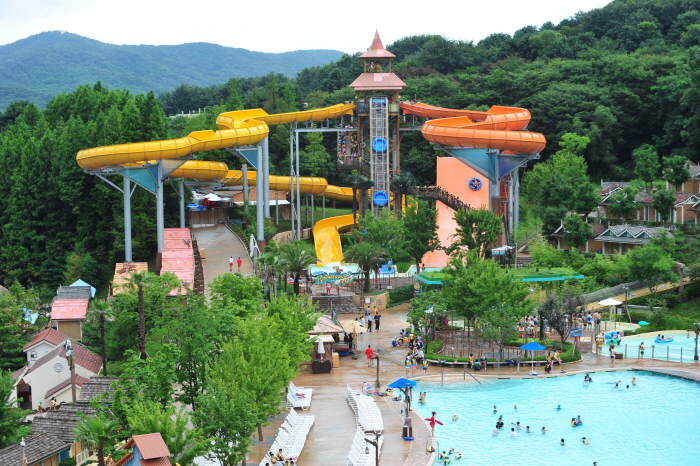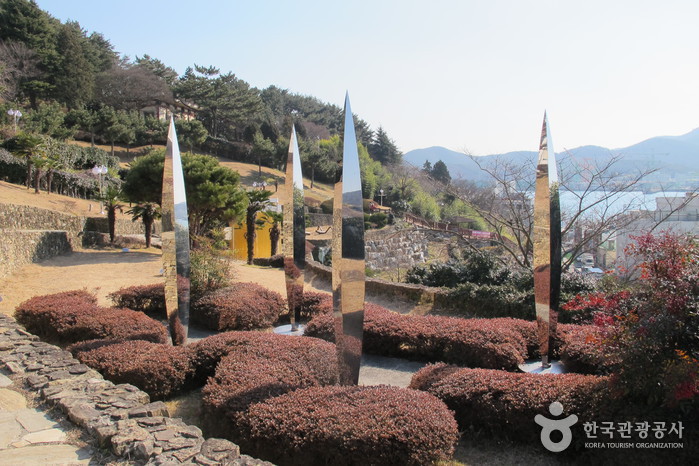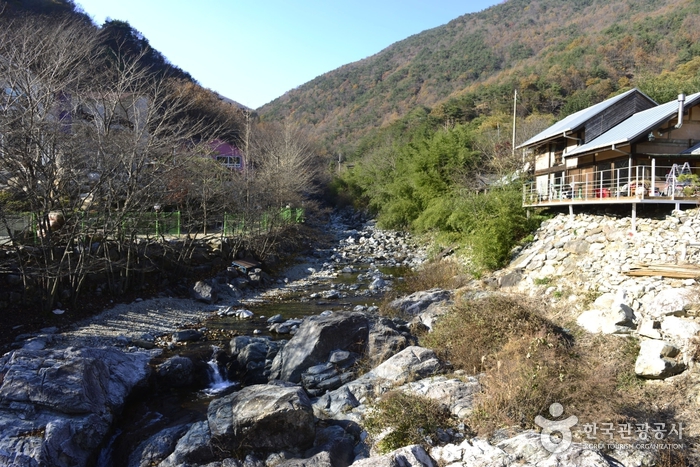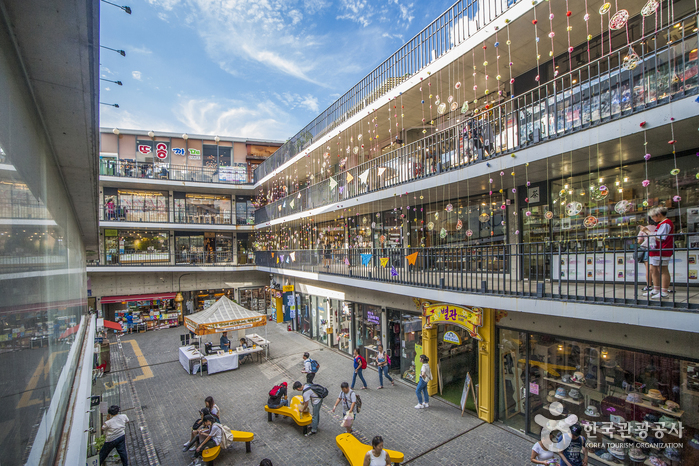Caribbean Bay (캐리비안베이)
2023-03-24
199, Everland-ro, Cheoin-gu, Yongin-si, Gyeonggi-do
+82-31-320-5000
Caribbean Bay is a world-class water park with various attractions and health facilities based on the theme of the Caribbean coast. Attractions include an artificial wave pool with a x_width of 120 meters and a length of 104 meters, a lazy river that passes through indoor and outdoor pools, and various slides that maximize adventure and thrill. Indoor facilities include a wave pool, slides, spas, and saunas. One of the park's best attractions is Mega Storm, a large, complex water slide. The circular tube starts from the boarding platform 37 meters above the ground and travels 355 meters rotating in all directions and going up and down three rapid descents. The last part of the ride is a large 18-meter funnel-shaped tornado that gives riders a zero gravity experience for about 55 to 60 seconds.
Nammangsan Sculpture Park (남망산 조각공원)
2025-03-22
29, Nammanggonwon-gil, Tongyeong-si, Gyeongsangnam-do
+82-55-650-2620
Nammangsan Sculpture Park was established to display the works of 15 famous sculptors from 10 countries who participated in the Tongyeong International Sculpture Symposium. It is also a popular spot for dates because this 30 square kilometer land has beautiful sculptures from which visitors can feel the individual taste of the artists.
Baegundonggyegok Valley, Sancheong (백운동계곡(산청))
2019-12-19
Baegun-ro 51beon-gil, Danseong-myeon, Sancheong-gun, Gyeongsangnam-do
+82-55-970-6421~3
If you go 5 km up along the valley at Baegam-ri, under the thick woods, you will find a 180 square meter long stone named ‘Jeomjeong Rock’ and a small waterfall. This valley is Baegundonggyegok Valley. For almost 6 km, the water of the valley flows over only rocks, with over twenty large and small falls and lakes. Large stones in the valley are gorgeous because the stones are washed with sunbeams and the strong current of water. The most famous falls are Baeunpokpo Waterfall and Odampokpo Waterfall. Strong current of water flows in Deungcheondae, where the letters ‘Yeongnamjeilcheonsok’ are carved. Baegundonggyegok Valley is a clean area due to maintenance of the clean natural environment. Many tourists visit here because the valley is decorated with azaleas in the spring and it is cool in the summer.
Insa-dong (인사동)
2024-05-17
62, Insadong-gil, Jongno-gu, Seoul
+82-2-734-0222
Insa-dong, located in the heart of the city, is an important place where old but precious traditional goods are on display. There is one main road in Insa-dong with alleys on each side. Within these alleys are galleries, traditional restaurants, teahouses, and cafes.
The galleries are the heartbeat of Insa-dong. There are about 100 galleries in the area offering every example of traditional Korean fine art from paintings to sculptures. The most famous galleries are Hakgojae Gallery, which functions as the center of folk art, Gana Art Gallery, which promotes many promising artists, and Gana Art Center.
The teahouses and restaurants are the perfect complement to the galleries. They are hidden deep within the twisting alleyways, making it feel like a treasure hunt. The shops in Insa-dong are very popular among all age groups, because each one is unique.
Every Saturday from 14:00 to 22:00 and Sunday from 10:00 to 22:00, the main street is blocked to vehicular traffic and it becomes a cultural space. Stores set up booths outside and Korean candy merchants and fortune teller stalls can easily be found; there are traditional performances and exhibits as well. Insa-dong is especially popular among international tourists. This is where they can experience and see traditional Korean culture first-hand, and also purchase pieces of fine art.
East Nine Royal Tombs [UNESCO World Heritage] (구리 동구릉 [유네스코 세계문화유산])
2024-03-20
197 Donggureung-ro, Guri-si, Gyeonggi-do
+82-31-563-2909
The East Nine Royal Tombs, situated on the eastern outskirts of Hanyang (the Joseon dynasty capital), represent a significant collection of nine royal burial sites. This area serves as the final resting place for seven kings and ten queens from the Joseon era. The surrounding forest paths are accessible to the public during the spring and fall seasons. Additionally, the East Nine Royal Tombs Healing Culture and Arts Festival takes place here every autumn, offering a blend of cultural and artistic experiences.
Bukhansanseong Fortress (북한산성)
2020-03-26
375, Daeseomun-gil, Deogyang-gu, Goyang-si, Gyeonggi-do
+82-31-968-5325
First built in 132 during the Baekje era (18 BC-AD 660) under King Gaeru's reign, Bukhansanseong Fortress was the northernmost fortress that protected Baekje from Goguryeo's forces. In the year 475, the fortress fell in the hands of Gogyuryeo after a fierce battle. As a result, King Gaeru was killed and Baekje's princess fled to Ungjinseong Fortress. Despite the fortress' collapse and reconstructions, Bukhansanseong Fortress continued to play an important role in protecting the capital city throughout Korea's history of war.
Itaewon Special Tourist Zone (이태원 관광특구)
2024-11-27
196 Itaewon-ro, Yongsan-gu, Seoul
Itaewon was the first special tourist zone in Seoul, designated in 1997. It is a multicultural place where over 20,000 foreigners live and is widely recognized by international visitors.
The name Itaewon started to spread worldwide in the 1980s when Korea hosted the 1986 Seoul Asian Games and the 1988 Seoul Olympic Games, as well as many international conferences. Since then, Itaewon has become a popular travel destination. Clothes and accessories with unique designs, and leather products in particular are famous. This is a go-to place for both shopping and entertainment. The street is crowded with shops selling clothes and bags, as well as hotels, restaurants, entertainment facilities and travel agencies. With about 2,000 shops and stores lining every street, visitors can experience a multicultural atmosphere. Also famous in the district is Antique Furniture Street where more than 100 shops selling furniture and antiques stretch from Hamilton Hotel toward Bogwang-ro.
Travelers can taste authentic cuisine and experience culture from around the globe on World Food Street where there are 40 restaurants operated by foreigners. Since the late 1990s, an increase in the number of tourists from Southeast Asia and the Middle East has transformed the streets from being US Army-oriented into culturally diverse. Various performances and events are held in the area. In particular, Itaewon Global Village Festival, held every October, is a famous festival. Tourists can pay in US dollars, Japanese yen, or another currency freely. In addition, visitors can use various languages like English, Japanese, and Chinese with the sellers.
Deogyusan National Park (Namdeogyu Section) (덕유산국립공원(남덕유분소))
2021-07-13
Sojeong-ri, Geochang-gun, Gyeongsangnam-do
+82-63-322-3174
Designated as a national park in 1975, Deogyusan National Park covers four counties. Besides Hyangjeokbong Peak, Deogyusan Mountain's highest peak in Muju, all the other peaks lie within Geochang. While the park features beautiful waters and rocks at Wolseonggyegok Valley in Buksang-myeon, Geochang, it also boast nature's beauty in Muju with creeks and valleys like Mahakdong Valley, Sangyeodeomgyegok Valley, and Songgyesa Valley.
Jogyesa Temple (조계사(서울))
2024-10-25
55 Ujeongguk-ro, Jongno-gu, Seoul
As the main temple as well as the district head temple of the Jogye order in Seoul, Jogyesa Temple is the center of Korean Buddhism. The temple was built in the late 14th century during the Goryeo period but was completely destroyed in a fire. It was rebuilt under the name of Gakwangsa Temple in 1910 with the effort of many respectful monks, namely Han Yong-un and Lee Hee-gwang. The temple was given a role as the head temple of Korea’s Buddhism and renamed to Tegosa Temple in 1936. In 1954, a purification drive took place to eliminate Japanese influence and revive traditional Buddhism, which established the present day Jogyesa Temple as a result.
Jogyesa Temple plays an important role in Korean Buddhism as the head temple of the Jogye order. Jogyesa Temple’s Dharma Hall serves as the main venue for several Buddhist events, holding rituals, lectures, ceremonies, and other events all year long. The annual lantern festival in celebration of Buddha's birthday also takes place at this temple.
Jongmyo Shrine [UNESCO World Heritage] (종묘 [유네스코 세계유산])
2024-07-05
157 Jong-ro, Jongno-gu, Seoul
+82-2-765-0195
Jongmyo Shrine was the primary place of worship for kings and their queens throughout the Joseon dynasty. The shrine was built at the same time as Gyeongbokgung Palace, under the orders of King Taejo, the first king of the Joseon dynasty. The shrine is the site of the royal memorial service, called Jongmyo Jaerye, a national event that has been passed down since the Three Kingdoms period. During the Joseon dynasty, the ritual was held on the first month of a seasonal change and the twelfth month of the lunar year.





 English
English
 한국어
한국어 日本語
日本語 中文(简体)
中文(简体) Deutsch
Deutsch Français
Français Español
Español Русский
Русский